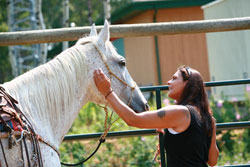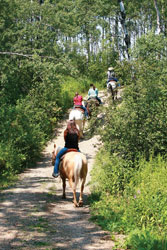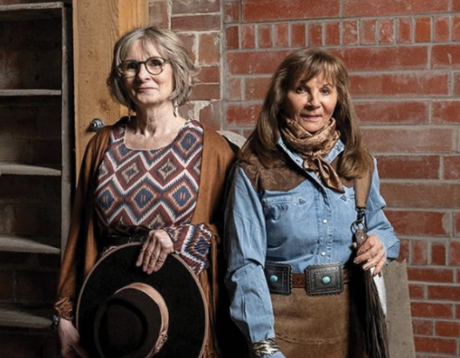Nekaneet Horse Program
Inside the Okimaw Ohci Healing Lodge
Written By Tom Reardon
Photos By Gary Houston
 |
| (L to R) Shaya on Roger, Bridgette on Rocky, Lisa on Partner and Dale on Razor pause in front of the prison’s Spiritual Lodge |
There’s nothing… so good for the inside of a man as the outside of a horse.”
Those words are attributed to Lord Palmerston, ca.1890. Revised versions of that quote were used in speeches delivered by Teddy Roosevelt, Winston Churchill and Ronald Reagan. Dale Mosquito agrees with them, and figures the adage applies to women too – and he’s proving it.
Make no mistake about it; Dale Mosquito is not a greenhorn. He’s been on the winning team at the Maple Creek Ranch Rodeo four times. When he’s mounted in that competition he and his horse seem to glide about the arena as swiftly and silently as the shadow from a gopher-hunting hawk skims across a fresh cut hay field. Seasoned cowhands know his value as a team-mate because he’s always in the right place at the right time.
 |
| With the support of the Nekaneet band, Dale and Marie convinced Correctional Service of Canada officials to try the horse program with empowering statements such as; “Horses allow us to unite unconditionally with another living being.” |
There’s also a group of women that appreciate Dale’s merit on a team; they’re the staff and residents of the Okimaw Ohci (OH kee maw OH Chee) Healing Lodge on the Nekaneet (Knee can neet) First Nation in the Cypress Hills. When the Lodge opened in 1995, its mandate was to rehabilitate federally sentenced Aboriginal women. The facility’s success is reflected in an extremely low repeat offender rate. Now, the 44-bed prison is classified to accommodate federally incarcerated women regardless of race, providing they are minimum or medium security, apply for transfer and meet approval. It is administered and monitored by Correctional Service of Canada and has been toured by prison officials from Australia, England, Hong Kong, Scotland and the United States.
Dale, a rancher and elected band councillor, felt horses would be of great assistance to the healing process. With the band’s support, he and his wife Marie Stanley (a health care director in the community) prepared a proposal for Correctional Service bureaucrats.
Permission to try the fledgling Nekaneet Horse Program as a pilot project came in 1998. The month-long program is optional but with increased enrolment, there are now four sessions annually (one per season). Clare McNab is the institution’s Kikawinaw, (Kee COW when now) Cree for “our mother” Anywhere else, she’d be known as the warden. She takes a hands-on approach and participated right alongside the inmates in an earlier session.
 |
| Inmate Lisa Vivier petting saddle horse Rocky. Alane Millions-Kendall says, “I believe it (a horse program) is beneficial for anyone who has difficulty connecting with people in one way or another to overcome trust, respect and personal belief issues.” |
“The Lodge is very fortunate to be able to offer the horse program,” says Clare. “In the healing process we hope to open women to ‘light bulb’ moments, when they understand more about themselves. The horse program offers those moments and assists the women on their healing journeys. It compliments the other programs we offer.”
The manager of those programs is Janice Many Grey Horses; she’s called the Kikawisinaw (Kee kah WISS sen now) (our Aunt) and says, “Horses have healed a lot of hearts here – then the recovery can start. The inmates change a lot in that month. The horse program has a calming effect on them which helps open their ears and that’s good because the first lesson in learning is listening.”
Keep in mind; these women have major issues that resulted in a prison sentence. Their crimes range from drug offences to murder.
Aware that many of the residents have problems with men, Dale has engaged several gifted horsewomen as support staff. His teachings are the base of the course but any physical aid (help with bridling, saddling or getting on) is given by a female employee. The program starts with tiny steps since most of the participants have never as much as touched a horse and are quite apprehensive. They are introduced to the equestrian world via classroom sessions dealing with equine anatomy along with tack names and uses. Once those lessons are absorbed, it’s out to the barn for tutoring in haltering, saddling, horse care and even tying a bowline knot. A few days into the course they mount up for some in-corral riding instruction. Eventually, the women are competent enough that when accompanied by Dale and an aide they can ride the trails through the trees, across the meadows and up and down the hills of the Nekaneet First Nation.
 |
One of those aides is Alane Millions-Kendall; she owns a ranch near Eastend, Sask., but rents it out since she resides in her Australian husband’s homeland. Most years she and her family travel to Canada to renew acquaintances and enjoy the summer. Knowing Alane as a top hand, Dale recruited her to help with a course. Last fall she asked if he would be offended if she set up a similar program Down Under. Dale replied, “If it will help somebody over there, you get right at it.” In April she emailed; “I have started ‘Second Wind Horse Programs’ here in Australia. It’s structured for kids who have been kicked out of mainstream schools because of behavioural problems. It will run through a school called “Back on Track” as part of the curriculum. So, Dale’s program has inspired me to support young people and address the issues hopefully before they end up in the correctional system.”
Alexandra McDougald has tried a few saddle broncs at a rodeo school, won the horsemanship trophy at the ‘04 Miss Rodeo Canada pageant and helped with the Nekaneet Horse Program. She says, “If I could work there everyday for the rest of my life, I would. It’s hard to know when those girls last smiled, but it was good to see when it happened out there. It’s the most rewarding thing I’ve ever done.”
Canadian Forces veteran Angel Shaw is a riding instructor and equine therapist. She recently relocated from Rocky Mountain House, Alta., to Kamloops. B.C. Prior to her move, she helped with four sessions. Now, in spite of the additional distance, she’s looking forward to number five. “Because I believe in it,” she affirmed. Angel has also attended the B.C. Equine College in Vernon and states, “Horses are great healers, they provide the inmates with peace and tranquility from a partner that has no expectations of them.”
| The Cree knew the Cypress Hills as The Thunder Breeding Hills; Okimaw Ohci means Thunder Hills. |
Rancher Bill Caton and his wife Sherry Wright live south of the First Nation. Sherry has aided with many aspects of the program and loved every minute of it. Bill was so impressed by the stories told at the supper table that he wanted to donate a gelding to the cause, but just couldn’t see himself giving anything to the government. At a meeting of the minds, another option was discussed; it’s called the Iskwewak (ISS kway walk) (woman) committee – the voice of the inmates. Bill gave the sorrel to them; they named him “Free Spirit” and loaned him to the program. Problem solved. Bill’s gift is contributing and the government doesn’t own him, the women do. Iskwewak committee membership is ever-changing; when someone is transferred or paroled a new resident arrives.
The inaugural class had 14 students but 10 seems a better fit. The program is not just a ride through the countryside, it’s a learning experience. Each participant renews life skills that she can take with her upon release. In part, that’s because Dale adds impromptu tests to every outing. During each ride he’ll demonstrate a manoeuvre; then invite the students to try it. Patience and perseverance are required as they work through it until they gain the desired movement from their horse. Even a sidepass can be a daunting task to someone with minimal experience, but once it’s achieved it generally creates a smile. Responsibility is promoted because everyone must take care of her horse, tack and barn chores. “We strive to produce a short term relationship that creates a long term impact,” says Dale.
Darlene Sanderson took the winter session this year and recalls, “When I first went around the horse I admired him from a distance with a wall in between. There was no trust and a whole lot of fear.” At the end of the course she wrote, “The Horse Spirit is a powerful teacher. I find when I am feeling happy, sad, frustrated and lonely I can go see them and they will listen and accept me because they do feel/sense your discomfort and tears. They comfort me and nudge me as to say, ‘it’s okay, I’m here and I hear you’.” Darlene was paroled in July.
| The Okimaw Ohci Healing Lodge is the result of a task force that realized the conventional prison system was not working for Aboriginal people. Some media referred to it as ‘the revolving door’ because of the high rate of indigenous re-offenders. That was a misnomer. For many Native women the door was not revolving but closed forever due to suicide.The task force called for a new approach in meeting the unique needs of Aboriginal women. The healing concept is about respect and learning boundaries. It involves non-judgemental staff, spiritual teachings from Elders and regimented programs. The inmate’s profile determines which programs are mandatory, such as a three-month substance abuse program or a four-month course for those with a history of violence. Literacy and education are offered as well. The results are proving the task force recommendations were correct. |
The president of the Iskwewak committee is Bridgette Bruyere. “You must be aware of things around you when you are on a horse,” affirms Bridgette. “If you don’t pay attention he will know. It’s like things in everyday life. When someone gives you a bottle or drugs you’re beat because you’re not paying attention to what’s going on around you. The horse is like an addictions program, it will teach and show you different things. The horse teaches us everyday life. If we choose to, we can live by those teachings.”
Prior to taking the course, Lisa Vivier had never been near a horse. “Horses taught me about trust and determination because I was scared of them,” confesses Lisa. “But mostly they showed me that I can succeed.”
Committed to the ancient teachings, Dale explains, “The Healing Lodge was our late Chief Gordon Oakes’ vision. His dream included having a ‘Horse Dance’ at the opening ceremonies and we did.” Then he stated emphatically, “The Nekaneet Horse Program has evolved from that day on.”
The Cree word for horse is mis-atim (MISS ah tim) (big dog). Legend says mis-atim was sent by the Creator to improve life, so the program is a blend of Cree protocol and equine therapy. Each day begins with spiritual teachings from Elders plus horse related schooling, instructed by Dale, an aide or guest speaker. The term ‘Elder’ has more to do with wisdom than age. Harry Francis is a very young Elder and a savvy horseman. Dale says, “Harry is the stick that stirs the whole pot. He brings everything and everybody together in our program.”
For the past several years, Dale has teamed with retired R.C.M.P. Sgt. Jerry Fedorowich to lead Maple Creek’s annual rodeo parade. Clad in buckskin with his characteristic black braid trailing down his back, Dale rides with a colourful blanket between him and his mount using only a single-rein native war bridle for guidance. Jerry, wearing his red serge and using R.C.M.P. tack, rides the parade route alongside Dale. That same weekend they provide a mounted escort for the flag bearing Rodeo Queen as they open each performance of the pro rodeo.
Now, Dale and the Nekaneet Horse Program are opening something else, something much bigger. They are opening new trails for corrections and rehabilitation – and the world is watching.
Tom Reardon is a working cowboy and the manager of the Meyronne Community Pasture deep in southern Saskatchewan. He describes himself as “a professional saddle tramp with fascinating friends.”
















